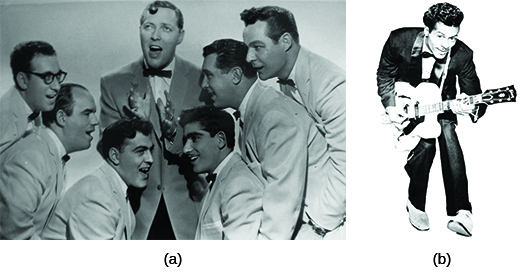| << Chapter < Page | Chapter >> Page > |
With a greater generational consciousness than previous generations, the baby boomers sought to define and redefine their identities in numerous ways. Music, especially rock and roll, reflected their desire to rebel against adult authority. Other forms of popular culture, such as movies and television, sought to entertain, while reinforcing values such as religious faith, patriotism, and conformity to societal norms.
In the late 1940s, some white country musicians began to experiment with the rhythms of the blues, a decades-old musical genre of rural southern blacks. This experimentation led to the creation of a new musical form known as rockabilly, and by the 1950s, rockabilly had developed into rock and roll . Rock and roll music celebrated themes such as young love and freedom from the oppression of middle-class society. It quickly grew in favor among American teens, thanks largely to the efforts of disc jockey Alan Freed, who named and popularized the music by playing it on the radio in Cleveland, where he also organized the first rock and roll concert, and later in New York.
The theme of rebellion against authority, present in many rock and roll songs, appealed to teens. In 1954, Bill Haley and His Comets provided youth with an anthem for their rebellion—”Rock Around the Clock” ( [link] ). The song, used in the 1955 movie Blackboard Jungle about a white teacher at a troubled inner-city high school, seemed to be calling for teens to declare their independence from adult control.

Haley illustrated how white artists could take musical motifs from the African American community and achieve mainstream success. Teen heartthrob Elvis Presley rose to stardom doing the same. Thus, besides encouraging a feeling of youthful rebellion, rock and roll also began to tear down color barriers, as white youths sought out African American musicians such as Chuck Berry and Little Richard ( [link] ).
While youth had found an outlet for their feelings and concerns, parents were much less enthused about rock and roll and the values it seemed to promote. Many regarded the music as a threat to American values. When Elvis Presley appeared on The Ed Sullivan Show , a popular television variety program, the camera deliberately focused on his torso and did not show his swiveling hips or legs shaking in time to the music. Despite adults’ dislike of the genre, or perhaps because of it, more than 68 percent of the music played on the radio in 1956 was rock and roll.

Notification Switch
Would you like to follow the 'U.s. history' conversation and receive update notifications?